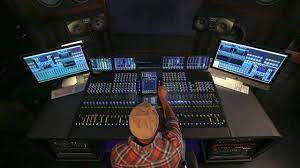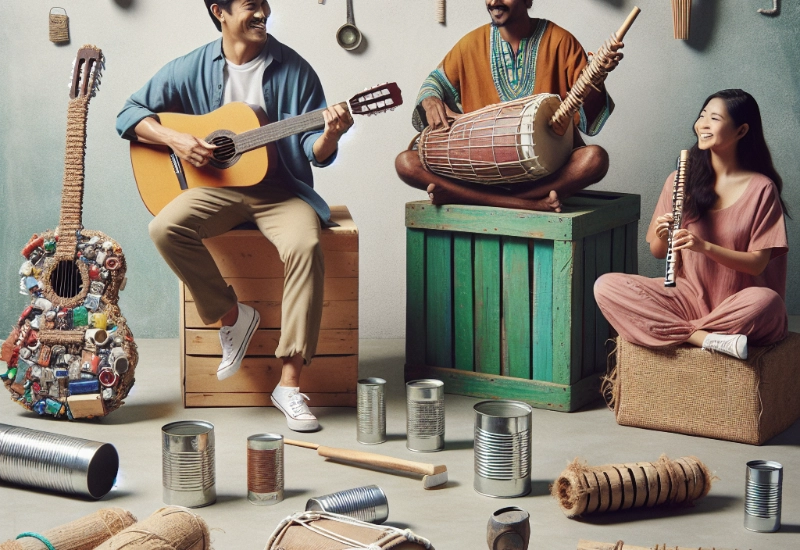Introduction
In today’s world, where sustainability is becoming a necessity, the creative industry is responding in remarkable ways. One such powerful response is the rise of recycled soundscapes — a musical movement that involves turning discarded objects, found sounds, and old recordings into meaningful new compositions. This is not just an artistic trend; it’s a form of environmental and cultural activism. Musicians across the globe are giving waste a second life — in rhythm, melody, and harmony.
What Are Recycled Soundscapes?
Recycled soundscapes are music compositions or performances created by reusing sound material — whether through sampling, ambient field recordings, or by building instruments from discarded materials. There are three major forms this movement takes:
- Sampling & Interpolation
Artists take short segments (or “samples”) from existing recordings — whether old records, radio broadcasts, or other sources — and rearrange them into new songs. - DIY Instruments from Trash
Musicians craft instruments using scrap metal, wood, plastic, glass, or even electronic waste. These range from violins made out of oil cans to drums made from garbage bins. - Environmental Audio Composition
Some creators record the natural sounds of recycling plants, construction sites, forests, or city streets and use those as raw material to design rhythms and sound textures.
Origins and Evolution
The idea of recycling sound is not new. In fact, it has deep historical roots:
- 1940s – Musique Concrète: French composers began cutting and rearranging recorded tapes of everyday sounds to create new audio experiences. This was the earliest example of manipulating “found sound” in music.
- 1970s–80s – The Rise of Sampling in Hip-Hop: DJs in the Bronx began looping drum breaks from funk and soul records. Over time, sampling became a defining feature of genres like hip-hop, electronic, and experimental music.
- Modern Era – Sustainability Meets Creativity: In the 2000s, with global focus on waste reduction, artists began intentionally using physical trash — not just sound — to raise awareness and promote eco-conscious art.

Real-World Examples of Recycled Soundscapes
1. The Recycled Orchestra of Cateura
In a community built on a landfill in Paraguay, young musicians formed an orchestra where every instrument is made from recycled trash — violins from paint cans, cellos from oil drums, flutes from water pipes. Their story is both musically beautiful and socially inspiring.
2. Fulu Miziki (Democratic Republic of Congo)
This Afrofuturist collective designs entire stage performances using instruments and costumes crafted from garbage found on the streets of Kinshasa. They represent a vibrant voice in both African music and sustainable innovation.
3. Coca-Cola “Recycled Records” Campaign
Producers like Mark Ronson and Madlib created music using sounds recorded in a recycling plant — bottle clinks, machines, conveyor belts — turning literal trash into catchy music with an eco-message.
4. Scrap Arts Music (Canada)
A percussion group known for large-scale instruments built from scrap metal, old bike parts, and industrial leftovers. Their concerts are visual and auditory showcases of recycled performance art.
5. The Garbage-Men (USA)
A youth band that built guitars, saxophones, and drums from cereal boxes, pipes, and tin cans — demonstrating that music education and sustainability can go hand-in-hand.
Why Recycled Soundscapes Matter
1. Environmental Awareness
Creating music from waste helps reduce pollution and landfill load. It sends a message that creativity doesn’t have to come at the cost of the planet. Musicians become advocates for greener thinking.
2. Creative Innovation
Recycled soundscapes push musicians out of traditional boundaries. Working with found or damaged materials sparks new approaches to rhythm, harmony, and sound design. Constraints lead to innovation.
3. Cultural Preservation
Sampling revives forgotten songs, instruments, and genres — giving old recordings new relevance. This is especially important in preserving local folk music, archival radio, or fading languages.
4. Accessibility and Education
DIY instruments are low-cost and often used in educational settings. Children can learn to build and play using recycled items, promoting STEAM learning (Science, Technology, Engineering, Arts, Math) and sustainability.
Challenges of Recycled Soundscapes
Despite the creativity involved, recycled soundscapes come with challenges:
- Legal Issues: Sampling copyrighted audio requires permission or licensing. Without it, musicians risk lawsuits or content removal.
- Durability and Sound Quality: Homemade instruments made from waste are often hard to tune or maintain. Weather and wear can also degrade their quality.
- Cultural Sensitivity: Borrowing sounds or styles from other cultures must be done respectfully. Misuse can lead to accusations of cultural appropriation or exploitation.
How to Create Your Own Recycled Soundscapes
Step 1: Collect Sound
Use your phone, a mic, or a field recorder to capture interesting sounds: bottle taps, rustling plastic, city traffic, machinery, birdsong, and more.
Step 2: Transform Audio
Using free software like Audacity or professional DAWs (Ableton, FL Studio), edit and manipulate the sounds — loop them, slow them down, add effects, or cut them into rhythmic patterns.
Step 3: Build Instruments
Try making a shaker from bottle caps, a string instrument from wood and wire, or a drum from a large can. You can use glue, nails, tape — anything safe and secure.
Step 4: Compose
Mix your live instrument sounds with your sampled rhythms. Experiment with layering, repetition, or even spoken word poetry.
Step 5: Perform or Share
Perform your track live using your DIY instruments, or upload it online as a form of eco-expression. Share the story behind each sound.

The Future of Recycled Soundscapes
This creative movement is growing globally:
- Music festivals are starting to use solar power and recycled materials in stage construction.
- Apps and remix tools allow users to build beats from environmental sounds.
- Educational programs now use recycled music-making as a method to teach both science and art.
- Green music labels are emerging, supporting only environmentally-friendly production.
With climate change and resource scarcity in focus, music may continue to evolve not only in sound, but in how it is made and what it stands for.
Conclusion
Recycled soundscapes represent the meeting point of imagination, responsibility, and transformation. By making music from waste, artists challenge the idea of what instruments should look like and how music should be made. More than just an aesthetic or technique, recycled soundscapes are a movement — one that uses art to restore value to what the world throws away.
As this trend grows, it tells a powerful story: beauty and meaning can come not from perfection, but from reinvention. From waste to wonder, from junk to joy — this is the sound of sustainability.







